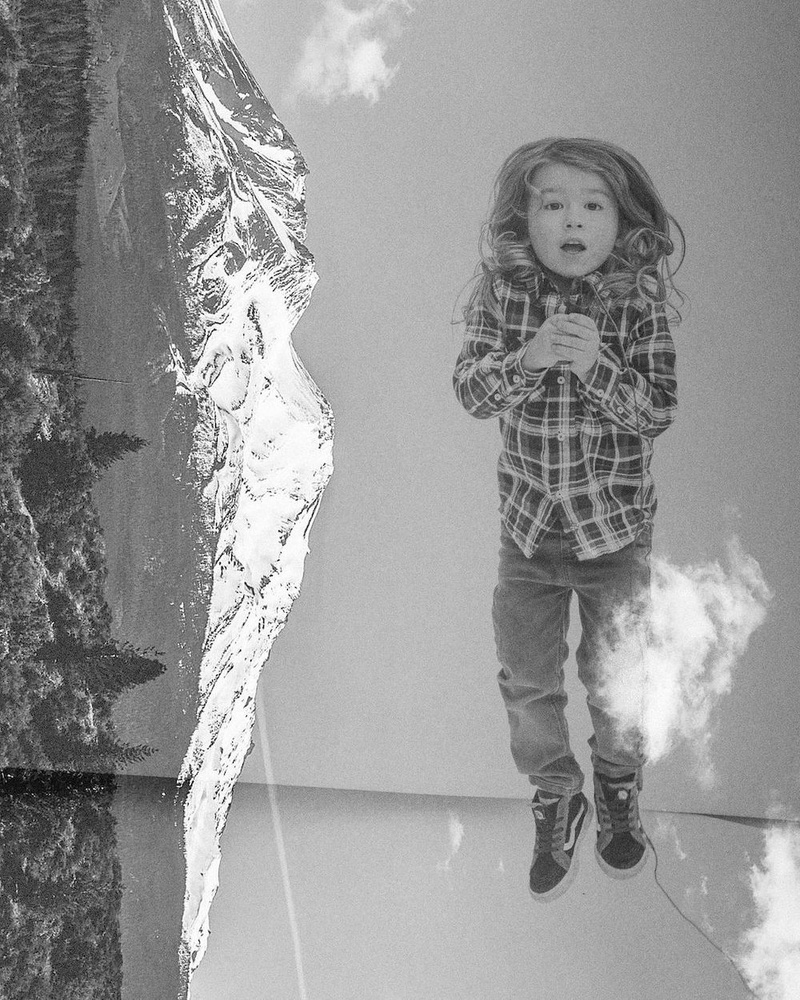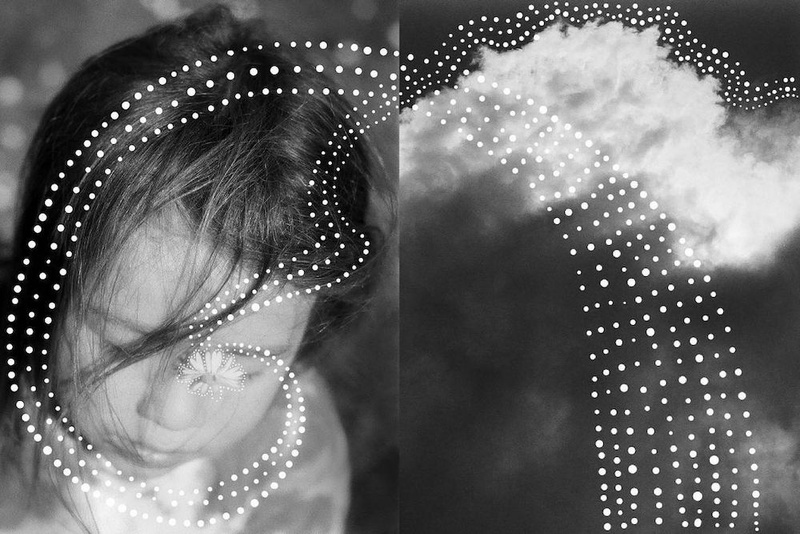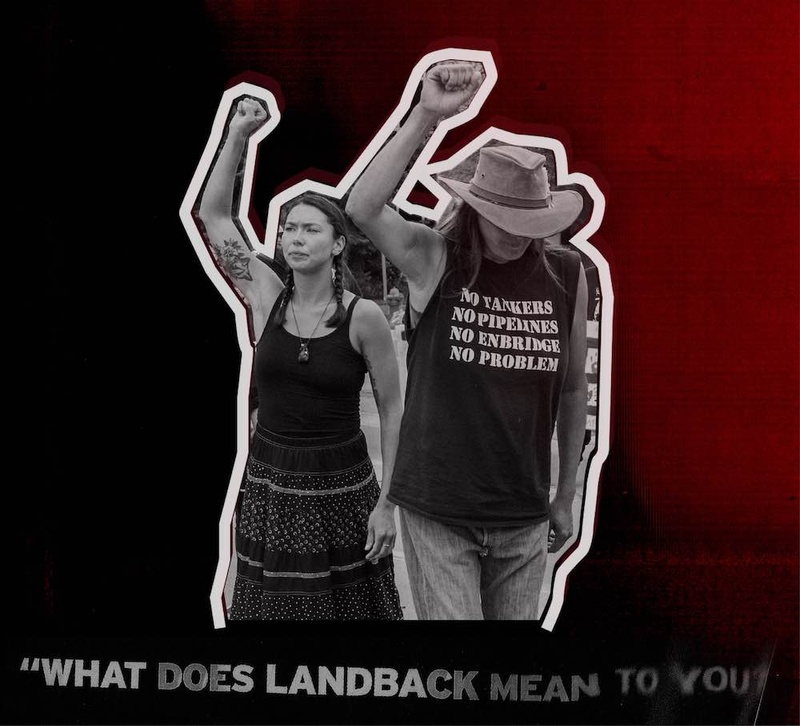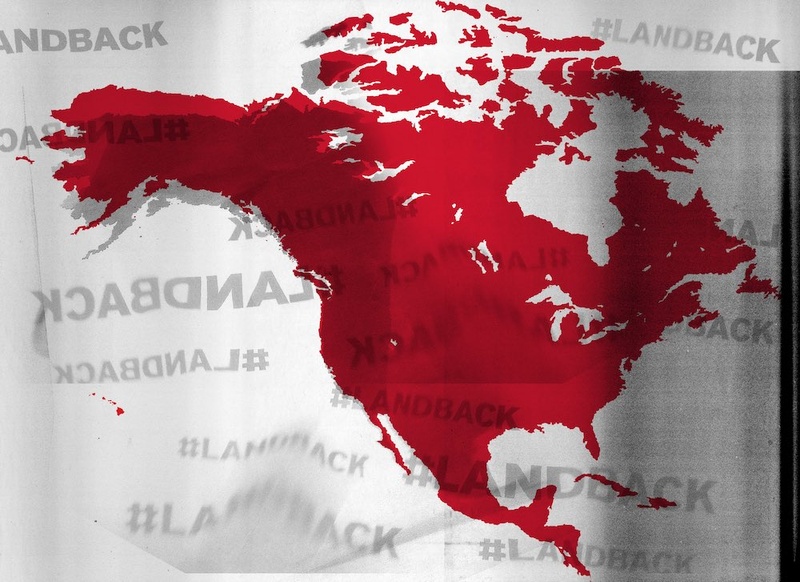I want to start with some of the recent work that you’ve posted on Instagram. Some of them include portraits of your children and even your wife. I love the ones that are also superimposed on landscapes. Can you walk me through how and when you take these portraits?
Whenever I’m photographing around my family, there’s always this sentiment of documenting something that I know I’ll look back to and be like, “Oh, yeah, that happened, and this is how I felt around that time.” Documenting and preserving them reminds me that living a joyful life as a father is possible.
My father was also a photographer, but he was heavily addicted to alcohol, so whenever he would go shoot, he would end up drunk and give away photos for free—or lose photos. There was this chaotic element to him photographing. He hardly ever photographed me. I was like, “What a weird thing that I had a father whose job was to document shit, but he never documented me.”
With my own family, I want to honor them. They deserve my attention and my creativity. And as I’m doing this, I’m weaving a path to heal my inner child, to be honest. I want to heal how my inner child feels about not being seen or not being recognized or not being protected.
I think that that’s really important, because I want my images of my family to be a representation for our future generations to say, “Okay, this is the time where things changed,” or “This is the generation where things get better for our lineage.” That’s important because we all have that opportunity. My dad had that opportunity, and my grandpa had that opportunity, and so on. But my own personal experience was horrible with my father, to the point where I knew that I have to turn it around in my generation.
Can you talk to me about what an inner child means to you?
I grew up in Mexico, in Guanajuato, the State of Guanajuato. My mom and my dad obviously had a lot of issues with alcoholism, and my father’s alcoholism specifically. My mom had to choose, and really take a leap of faith, to try to make a better life for ourselves, so she came to the United States when I was seven. She went to California to work and make enough money to bring us here. But at seven years old, my father obviously wasn’t responsible enough to care for me as a child, so I ended up on the streets. From 7 to 11, I was on and off under the sewers or under bridges, just things like that, that were not for a child.
As I go through my healing journey as an adult, as I’m going through therapy sessions, as I’m going through ceremony, finding a path back to my healing through my ancestors, there’s an image that I get constantly, which is me as a child, and how neglected that child was. He wasn’t fully nurtured. Maybe there were beautiful moments, and they were the best that my parents could do. And while I’m compassionate about their own healing, the truth is that seven-year-old me is still wondering, like, “Wait, hold on. What is this? Is this safe? Is this a good place to be?”
When I think about my inner child as an adult, I want that inner child to know that he is protected, that he is nurtured, that he is loved, and that he is seen. When I make my work, a lot of it is rooted in me trying to be visible, and trying to be seen, and trying to nurture that little seven-year old me on the streets, seeing shit that I shouldn’t have seen, to ensure that little kid is acknowledged. It’s that first step of healing—acknowledgement—that I’m trying to do with my inner child right now.
That’s where I weave back to why we need to acknowledge Indigenous peoples. If we can’t even do that, then how the fuck are we going to heal? Whenever I make these images of my son or my daughter, and I’m documenting indigenous communities, I see myself in this. They are me, I am them. We’re not separate. But I’m still figuring it out. There’s still a lot of room for improvement there.
It’s like you’re healing your own inner child through your family. That way they have an imprint or template to continue a similar healing path.
Yeah. It’s almost like modeling what it could have been for me. I could have totally fallen into different addictions, like, “Yo, I’m just going to be like everybody else here, and do the same drugs that they do, and die at the age of eight.” But I think that there’s so much more. I know that I came to this earth to live. And I think that’s why I do what I do. Finally, as an adult, I can say that out loud. That inner child who survived the streets knew he was here to live.
But that meant moving to a different country and not speaking the language, and be like, “What the fuck is this?” I think that culturally, too, the United States is a super different culture, very extractive, in comparison to what I know about Mexican culture. People were real with each other. They’re community-based, not individual-based. But yeah, I think that’s another conversation. One day, I’m going to do a second interview for you, and we can talk about it more.
Deal. I’m looking at a photo of one of your kids jumping in midair. There’s a mountain tilted 90 degrees so that it’s parallel to your child. How do you choose to layer your pictures?
For that specific image, it’s an image of Mount Shasta in California and my son. Whenever I do these double exposures, these layerings, there’s always this coding that’s happening. I have to find the right image, and I have to make sure that I’m personally in a state of vulnerability. That’s a key part of my process. As a storyteller, I need to be vulnerable in order for the image to be vulnerable. When I’m editing these images, when I’m putting them together, I need to be in a vulnerable space to make sure that whatever I come up with or whatever I decide to layer on top of each other shows what I’m feeling.
I also like to move things around a lot. I like to put things upside down so that you’re not so constrained and so linear about seeing the work. There’s so much room for exploration with storytelling, especially with image-making. A lot of us get so caught up with the way things need to be instead of the way that things could be. We say either/or, this or this, instead of this and this. As a creative, that’s where I’m going toward. Can I make something that represents my own emotions, the emotions of my son, and make someone else that doesn’t even know us have some form of emotion?
The picture of Mount Shasta was from a road trip, but that image of him flying, that’s actually him doing a self portrait with the little shutter release in his hand. He likes to jump a lot, so I was just like, “Yeah, just jump.” And then he jumped and took the photo. I’m not going to post these images on social media by themselves. But when I repurpose them, and layer them together, I find a way to make something that’s for me. I’m not making it for somebody else, I’m making for my own self. From there, whenever I post it, I think that people resonate with that.
Could talk a bit about the process of writing the poems you create and add to your layered photographs?
Writing has been such an interesting tool to work with for my creative process, because English is not my first language. Whenever I try to rationalize what I’m thinking, I think in Spanish, because that’s how I grew up. I go from Spanish to a language that is harsh and doesn’t have a romance that I resonate with.
With that being said, whatever I write, I’m not doing it for anybody. I’m doing it to remember the feelings and thoughts that I have when I’m vulnerable. I just try to translate them as best I can to a language that, one, I resent the fact that I have to speak this language. Two, I’m trying to understand the concept of what we call America—and the concept of what we call English—which is still very new to the Indigenous people from this part of the world. I actually don’t let myself feel bad for not writing English properly. It’s okay for me to speak English and to write English how I think and how I feel, because it’s not writing from the brain, it’s writing from the heart. I usually pair them with the images I’m making when there’s something inside of me that I need to get it down.
Where do these words, or from whom do these words usually come from? Are they people in your life, past or present? Are they teachers? Are they your family?
I don’t want to get too spiritual about it, but for me, it does come from a higher source. It doesn’t come from me. I’m just the channel. I get to be the radio station for this, for these thoughts, these feelings, and these intentions to come through. That’s why you always see the artist on stage. That’s why you don’t get to see them backstage, when they’re by themselves, with nobody around them, while there’s like 10,000 people outside waiting for them. For me, the same thing is that I have to have a personal practice. I have to have some form of grounding, and community, and education happening in the background, so that I can step up and channel what I need to channel.
I’ve been using the pronoun—I guess you can say, or as much as I understand what a pronoun is—I’ve been saying “we,” and people are like, “Well, what do you mean, we?” I’m like, “Yeah. It’s me and my ancestors.” It’s not just me. I can’t take credit for all this. It wouldn’t be honoring the people that came before me, and demeaning if I just took credit for all these words. Whenever I have to step into the place that I need to create something, I reach out to them. Those are the first steps. You go back and you listen. You meditate. You go back to the ceremony, and you try to sacrifice for the people and not just for yourself.
I think you just blew my mind twice there. Artist as radio station, and using the pronoun we to refer to and give thanks to the people that came before you. It makes me wonder if you consider your family, your ancestors, and maybe even the people that will come after you, part of your artistic practice.
Yeah. I think that, as I’m learning, as I’m trying to make sense of, one, this experience as a human being, two, this experience as a family person, as a father, as a son, and as a husband, and three, this experience as a creative. All these different layers come in, and then I’m like, “Wait, hold on, I have to make sense of this.” If I’m not coherent in my understanding of myself, then how am I supposed to photograph other people? How am I supposed to go and interact in the world, and try to tell stories, and try to do projects if I can’t see myself? How can I tell someone else to see themselves if I can’t see myself?
A lot of the time, when I think about my family and my ancestors and the people I’ll never meet—even the people that will come and will have only an idea of who I am—I wonder if life is more than just past, present, and future. What if there’s a fourth element of time that creates a circle? That way it’s not just me living in 2021, doing an interview, but there’s also me in the past, that inner child, that informs this interview, and maybe even the old man I’ll become who’s looking back at this moment.
Maybe time works a little bit differently than how we’ve been taught. That time and space work this way just because we adopted it, just like the United States adopted the Constitution, or Manifest Destiny. We adopted these things as truths but never questioned them. But maybe there’s an opportunity to take another look at it, another way beyond just the linear. That’s why whenever I think of my ancestors, and my family now, and then the people that I’ll never meet, I do things as if I am in all spaces. Like, whenever someone gives me a compliment, I take the compliment for that little kid. Before, I would say, “No, no, no. Don’t compliment me. I’m just doing my thing. I’m going to try not to be shiny here. I’m literally just trying to proclaim my purpose.” But now I learned that I have to take some of those compliments for my inner child, for my ancestors, for the people that died in my lineage because of colonialism. Can I do that for them? Can I give them that honor?
I think that that’s what I’m doing right now. I’m receiving for those that came before me—and projecting an ambition for those that will come after me. It’s an opportunity to change the narrative. Maybe these images, maybe these stories, maybe these billboard campaigns, maybe whatever the heck I’m doing could change the route in the journey, and weave a different journey for the people in the future.
That brings us to the billboard campaign you’re working on with NDN Collective for LANDBACK.Art. I was curious if what we’re talking about—circular time, honoring past and future in the present—is informing the billboard you’re designing.
Yeah. I’m working on this piece with my friend, Brian Prince, who’s been a big part of this project and helped me bring it to life. He and I have known each other for almost 10 years. We lived in Orange County, in Fullerton, California, a really conservative place. When I finally came to this country, I realized a lot of the truths about being an Indigenous man in the United States and an Indigenous person on this planet. There are limits and boundaries that have been created for us. We didn’t create those boundaries. We didn’t ambition those boundaries. And that’s because a lot of the time we’re like the fish. The fish doesn’t understand what it’s like to be outside of water, because he’s always in water. So for me, borders and limitations, especially physical boundaries like the U.S.-Mexico border, are spaces and opportunities for me to say something else that I have in my heart.
Brian and I were talking through this process of, “What are we going to say?” and I automatically thought about the fact that I didn’t cross the border, but the border crossed me. A lot of Indigenous people feel that way. We have communities throughout the world, not just along the Mexican border, but throughout the world, that are saying, “You can’t come here, because you’re from over there.” And yeah, we’ve been glamorizing Manifest Destiny for a minute here, this idea that there’s a supremacy to who gets to travel around the world and who doesn’t, that if you have an American passport, you get to go to a lot of cool places, but if you’ve got a passport from another country, you might not be able to.
The image we’re going to work on is going to be a self-portrait actually, of my eyes, just looking, almost like, “We’re watching you, watching us, and we’re vigilant, too. And we’re aware.” In my personal practice, I envision a world where there’ll be no borders. When you look up in space, and you have a bunch of these really rich people trying to go up in space, they don’t see borders. I hope they don’t. But the privilege, to be able to see no borders, even that, just thinking about that, to me, it gives me anxiety about the fact that we, through art, can now say and express things that are going to become reality.
What we’re doing for LANDBACK.Art is envisioning together. We’re questioning together, and we’re gathering our thoughts, hopefully, so that we can, for example, imagine a borderless world. Because it’s not just about getting physical land back. That is one element of it, but it’s also about returning to the land. How can you return to the land if there’s a big old wall in front of you? There’s people that say, “Well, fuck that wall. We’re going to break those walls.” I think a lot of that sentiment comes through in this work, in this specific billboard. Everyone interprets what LANDBACK means differently. It’s so fluid at this point that it’s literally an opportunity for us to co-create it together.
What would your advice be for fathers trying to reclaim that sense of childhood ambition and excitement and joy?
I think, personally, having a set practice with my son and planting the seeds of curiosity have been really healthy for our relationship. I like having a sense that we are healing this together. For my son to understand that is important. He asked me, “Oh, dad, you lived on the street?” And I was like, “Yeah, I lived on the street, but it was okay.” For him not to worry about the fact that his dad went through hardship, and for me, by modeling my behavior, my tendencies, what do I do in life. He’s going to look at that. He’s going to be like, “What are you modeling for me, Dad?”
I think that’s what a lot of parents get scared of, is that as we go through our traumatized experience, we tend to re-traumatize ourselves sometimes, and then traumatize others. In retrospect, I think about my dad, and my father was traumatized, and my father was in pain, and it wasn’t for a child to understand that, but I think that’s where a lot of parents go south, it’s where we don’t have that self-awareness. We need the conviction to turn it around. We literally have the opportunity to flip the coin for the following generations. I think that’s what I will give as my own personal experience.
Josué Rivas Recommends:
5 Instagrams to follow
This content originally appeared on The Creative Independent and was authored by Daniel Sharp.
Daniel Sharp | Radio Free (2021-10-11T07:00:00+00:00) Creative director and educator Josué Rivas on healing your inner child through your work. Retrieved from https://www.radiofree.org/2021/10/11/creative-director-and-educator-josue-rivas-on-healing-your-inner-child-through-your-work/
Please log in to upload a file.
There are no updates yet.
Click the Upload button above to add an update.



